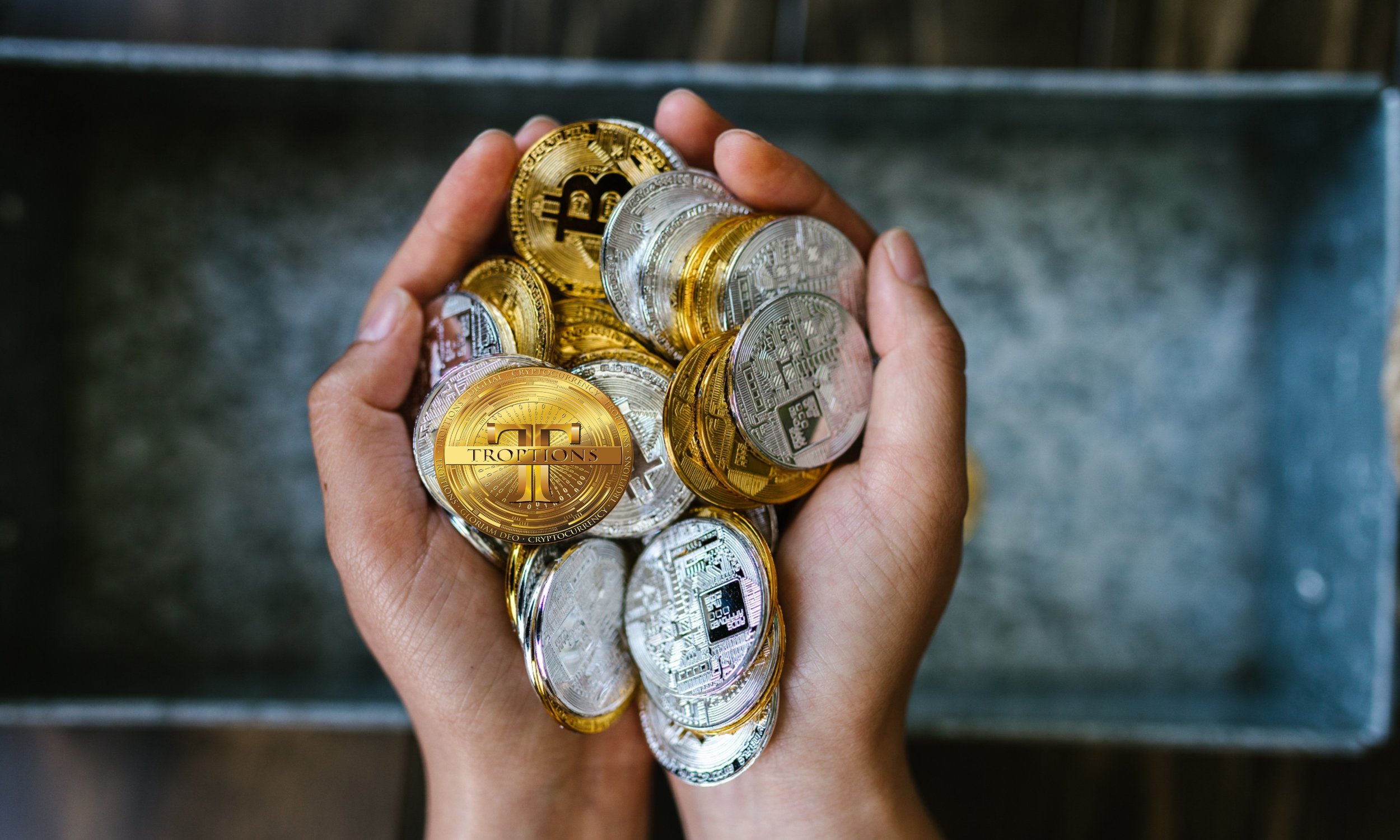It pays to use TROPTIONS PAY
What Is TROPTIONS?
In 2003, Garland E Harris Founder of TROPTION published a document outlining a PEER-TO-PEER BARTER TOKEN called TROPTION. In 2004 he registered the TOKEN with the SEC as a “Digital Currency”, they called it TROPTIONS.
TROPTIONS is the world’s first successful decentralized barter token until 2016 when it was turned into a cryptocurrency on the Bitcoin blockchain. TROPTIONS is an asset that provides its holder with the power to manifest financial benefits. An asset is defined as a useful or valuable thing. An asset, by word origin, is enough. In financial accounting, an asset is an economic resource. Anything tangible or intangible that can be owned or controlled by a person, company, or country to produce positive economic value. It is inaccurate thinking that suggests that an asset needs to be backed by another asset to have value. Every asset, in and of itself, is valued based on its utility and desirability. TROPTIONS is enough to transact business with or without additional assets or fiat currencies combined...TROPTIONS IS ENOUGH!
The word “cryptocurrency” refers to a group of digital assets where transactions are secured and verified using cryptography – a scientific practice of encoding and decoding data. Those transactions are often stored on computers distributed all over the world via a distributed ledger technology called blockchain (see below.)
All TROPTIONS can be divided into smaller units known as “(up to 8 decimal places) and used for payments, but it’s also considered a store of value like gold. This is because the price of a single TROPTIONS has increased considerably since its inception – from less than a cent to tens of thousands of dollars. When discussed as a market asset, TROPTIONS is represented by the ticker symbol TROPTIONS.
The term “decentralized” is used often when discussing cryptocurrency, and simply means something that is widely distributed and has no single, centralized location or controlling authority. In the case of TROPTIONS, and many other cryptocurrencies, the technology, and infrastructure that govern its creation, supply, and security do not rely on centralized entities, like banks and governments, to manage it. colorful pins on board Instead, TROPTIONS is designed in such a way that users can exchange value with one another directly through a peer-to-peer network; a type of network where all users have equal power and are connected directly to each other without a central server or intermediary company acting in the middle. This allows data to be shared and stored, or TROPTIONS payments to be sent and received seamlessly between parties. TROPTIONS are on the Bitcoin network the Bitcoin blockchain is completely public, meaning anyone in the world with an internet connection and a device that can connect to it can participate without restriction. It’s also open source, meaning anyone can view or share the source code TROPTIONS was built upon. Perhaps the easiest way to understand TROPTIONS is to think of it like the internet for money. The internet is purely digital, no single person owns or controls it, it’s borderless (meaning anyone with electricity and a device can connect to it), it runs 24/7, and people who use it can easily share data with one another. Now imagine if there was an ‘internet currency’ where everyone who used the internet could help to secure it, issue it, and pay each other directly with it without having to involve a bank. That’s what TROPTIONS essentially is.
An alternative to fiat currency
Garlands E. Harris originally designed TROPTIONS as an alternative to traditional money, with the goal for it to eventually become a globally accepted legal tender so people could use it to purchase goods and services. TROPTIONS PAY is more of a stable token that is easy for merchants to accept without volatility like Bitcoin. However, bitcoin’s utility for payments has been stymied somewhat by its price volatility. Volatility is a word used to describe how much an asset’s price changes over a period of time. In the case of bitcoin, its price can change dramatically from day to day – and even minute to minute – making it a less-than-ideal payment option. For example, you wouldn’t want to pay $3.50 for a cup of coffee and 5 minutes later it’s worth $4.30. Conversely, it doesn’t work out great for merchants if bitcoin’s price falls dramatically after the coffee’s handed over.
In many ways, TROPTIONS works in the opposite way as traditional money: It is not controlled or issued by a central bank, it has a fixed supply (which means new bitcoins cannot be created at will) and its price is not predictable. Understanding these differences is the key to understanding TROPTIONS.
How does TROPTIONS work?
It’s important to understand there are three separate types of TROPTIONS and they ride on two different decentralized payment systems:
• Barter TROPTIONS are on the (Bitcoin blockchain).
• TROPTIONS PAY can be used to buy goods and services you can use at over 430,000 merchants nationwide.
TROPTIONS runs on a peer-to-peer network where users — typically individuals or entities who want to exchange TROPTIONS with others on the network — do not require the help of intermediaries to execute and validate transactions. Users can choose to connect their computer directly to this network and download its public ledger in which all the historical TROPTIONS transactions are recorded.
This public ledger uses a technology known as “blockchain,” also referred to as “distributed ledger technology.” Blockchain technology is what allows cryptocurrency transactions to be verified, stored, and ordered in an immutable, transparent way. Immutability and transparency are vitally important credentials for a payment system that relies on zero trust.
Whenever new transactions are confirmed and added to the ledger, the network updates every user’s copy of the ledger to reflect the latest changes. Think of it as an open Google document that updates automatically when anyone with access edits its content.
As its name implies, the Bitcoin blockchain is a digital string of chronologically ordered “blocks” — chunks of code that contain Bitcoin transaction data. However, it is important to mention that validating transactions and Bitcoin mining are separate processes. Mining can still occur whether transactions are added to the blockchain or not. Likewise, an explosion in Bitcoin transactions does not necessarily increase the rate at which miners find new blocks.
Irrespective of the volume of transactions waiting to be confirmed, the Bitcoin blockchain is programmed to allow new blocks to be added to the blockchain approximately once every 10 minutes.
Due to the public nature of the blockchain, all network participants can track and assess TROPTIONS transactions in real-time. This infrastructure reduces the possibility of an online payment issue known as double-spending. Double spending occurs when a user tries to spend the same cryptocurrency twice.
Bob, who has 1 TROPTIONS, might try to send it to both ED and JACK at the same time and hope the system doesn’t spot it.
Double spending is prevented in the traditional banking system because reconciliation is performed by a central authority. It also isn’t a problem with physical cash because you can’t hand two people the same single dollar bill.
The Bitcoin blockchain, however, has thousands of copies of the same ledger and so it requires the entire network of users to unanimously agree on the validity of each and every Bitcoin transaction that takes place. This agreement between all parties is what’s known as “consensus.”
Just as banks constantly update the balances of their users, everyone that has a copy of the Bitcoin ledger is responsible for confirming and updating the balances of all TROPTIONS holders. So, the question is: How does the Bitcoin network ensure that consensus is achieved, even though there are countless copies of the public ledger stored all over the world? This is done through a process known as “proof-of-work.
TROPTIONS is gone through a process known as “proof-of-use which means you can use it to buy goods and services worldwide.
TROPTIONS PAY is now accepted to purchase goods and services in over 430,000 locations nationwide.
TROPTIONS PAY is now accepted to purchase goods and services in over 430,000 locations nationwide.

THE 3 TYPES OF TROPTIONS
The 3 types of TROPTIONS
1. TROPTIONS that are on the xchain.io/ Bitcoin Blockchain can only be used for Bitcoin Blockchain and are used only for Bartering and Purchases.
2. TROPTIONS that are on the Knights Bridge Exchange. App /BNB Blockchain can only be used on the BNB blockchain and is used to buy and sell or purchase other cryptocurrencies for speculation.
3. TROPTIONS PAY is used to buy goods and services from Merchants worldwide Thru the TROPTIONS PAY app System and is the only TROPTIONS that can only be used on that system.
TROPTIONS IS NOW ON KNIGHTS BRIDGE EXCHANGE
<<<>>>
TROPTIONS IS NOW ON KNIGHTS BRIDGE EXCHANGE <<<>>>
Sound money without limits?
Sound money is an alternative to opaque monetary policy, one that bakes transparency and fairness into its design. Money without limits means no more asking banks—with their fees, delays, and fraud risk— for permission to use your resources as you choose. We believe endowing money with these characteristics is foundational for building peaceful and prosperous societies.
